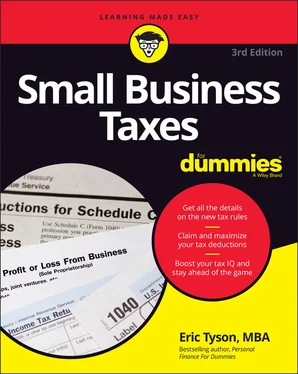In this section, I define important tax terms such as total taxes, taxable income, marginal tax rates, and corporate tax rates, and I also discuss the federal and state income tax systems.
Defining total taxes and taxable income
The only way to determine the total amount of income taxes you pay is to get out your federal and state tax returns. On each of those returns is a line that shows the total tax. Add the totals from your federal and state tax returns, and you probably have one very large expense!
Your taxable income is different from the total amount of money you earn during the tax year from employment and investments. Taxable income is defined as the amount of income on which you actually pay income taxes. You don’t pay taxes on your total income for the following two reasons:
Not all income is taxable. For example, you pay federal income tax on the interest that you earn on a bank savings account but not on the interest from municipal bonds (loans that you, as a bond buyer, make to state and local governments).
You get to subtract deductions from your income. Some deductions are available just for being a living, breathing human being. And, the Tax Cuts and Jobs Act greatly increased the standard deductions. For tax year 2021, single people receive an automatic $12,550 standard deduction, heads of household qualify for $18,800, and married couples filing jointly get $25,100. (People older than 65 and those who are blind get slightly higher deductions.) Other expenses, such as mortgage interest and property taxes, are deductible to the extent that your total itemized deductions exceed the standard deductions.
Your marginal income tax rate for federal income taxes
Marginal is a word that people often use when they mean “small” or “barely acceptable.” But with taxes, marginal has a different meaning. The government charges you different income tax rates for different portions of your annual income. So your marginal tax rate is the rate that you pay on the so-called “last dollars” you earn. You generally pay less tax on your first, or lowest, dollars of earnings and more tax on your last, or highest, dollars of earnings. This system is known as a graduated income tax, a system that goes back hundreds of years to other countries.
The fact that not all income is treated equally under the current tax system isn’t evident to most people. When you work for an employer and have a reasonably constant salary during the course of a year, a stable amount of federal and state taxes is deducted from each paycheck. Therefore, you may have the false impression that all your earned income is taxed equally.
Table 1-1gives the 2022 federal income tax rates for singles and for married people filing jointly.
 Your marginal tax rate is the rate of tax that you pay on your last, or so-called highest, dollars of taxable income. For example, according to Table 1-1, if you’re single and your taxable income during 2022 totals $55,000, you pay federal income tax at the rate of 10 percent on the first $10,275 of taxable income. You then pay 12 percent on the amount from $10,275 to $41,775 and 22 percent on income from $41,775 up to $55,000. In other words, you effectively pay a marginal federal tax rate of 22 percent on your last dollars of income — those dollars in excess of $41,775.
Your marginal tax rate is the rate of tax that you pay on your last, or so-called highest, dollars of taxable income. For example, according to Table 1-1, if you’re single and your taxable income during 2022 totals $55,000, you pay federal income tax at the rate of 10 percent on the first $10,275 of taxable income. You then pay 12 percent on the amount from $10,275 to $41,775 and 22 percent on income from $41,775 up to $55,000. In other words, you effectively pay a marginal federal tax rate of 22 percent on your last dollars of income — those dollars in excess of $41,775.
After you understand the powerful concept of marginal tax rates, you can see the value of the many financial strategies that affect the amount of taxes you pay. Because you pay taxes on your employment income and your investment earnings (other than retirement accounts), you need to make many of your personal financial decisions with your marginal tax rate in mind.
For example, when you have the opportunity to earn some extra money, how much of that extra compensation you get to keep depends on your marginal tax rate. Your marginal income tax rate enables you to quickly calculate the additional taxes you’d pay on the additional income.
Conversely, you quantify the amount of taxes that you save by reducing your taxable income, either by decreasing your income — for example, with pretax contributions to retirement accounts — or by increasing your deductions.
Actually, you can make even more of your marginal taxes. In the next section, I detail the painful realities of income taxes levied by most states that add to your federal income tax burden. If you’re a middle-to-higher income earner, pay close attention to the sidebar later in this chapter where I discuss the alternative minimum tax.
Your total marginal rate includes your federal and state income tax rates. As you may already be painfully aware, you don’t pay only federal income taxes. You also get hit with state income taxes — that is, unless you live in Alaska, Florida, Nevada, South Dakota, Tennessee, Texas, Washington, or Wyoming. Those states have no state income taxes. As is true with federal income taxes, state income taxes have been around since the early 1900s.
 You can look up your state tax rate by getting out your most recent year’s state income tax preparation booklet. Alternatively, Figure 1-1 gives you an idea of your state tax rates; it reflects state individual income taxes. Some states impose other taxes — such as local, county, or city taxes; special taxes for nonresidents; or capital gains taxes — which aren’t included in this table.
You can look up your state tax rate by getting out your most recent year’s state income tax preparation booklet. Alternatively, Figure 1-1 gives you an idea of your state tax rates; it reflects state individual income taxes. Some states impose other taxes — such as local, county, or city taxes; special taxes for nonresidents; or capital gains taxes — which aren’t included in this table.

Source: The Tax Foundation.
FIGURE 1-1:State marginal tax rates.
THE ALTERNATIVE MINIMUM TAX
In 1969, Congress created a second tax system — called the alternative minimum tax (AMT) to ensure that higher-income earners with relatively high amounts of itemized deductions pay at least a minimum amount of taxes on their incomes. When it was added to the federal income tax code in 1969, the AMT affected a mere 155 high-income taxpayers; in 2017 before tax reform was passed, it hit about 5 million taxpayers! Thanks to the Tax Cuts and Jobs Act, which took effect in 2018, AMT only impacts “just” 150,000 taxpayers annually.
If you have a bunch of deductions from state income taxes, real estate taxes, certain types of mortgage interest, large miscellaneous itemized expenses, or passive investments (such as limited partnerships or rental real estate), you may fall prey to the AMT. The AMT is a classic case of the increasing complexity of the U.S. tax code. As incentives were placed in the tax code, people took advantage of them. Then the government said, “Whoa! We can’t have people taking that many write-offs.” Rather than doing the sensible thing and limiting some of those deductions, Congress created the AMT instead.
The AMT restricts you from claiming certain deductions and requires you to increase your taxable income. So you must figure the tax you owe both under and out of the AMT system, and then pay whichever amount is higher. Unfortunately, the only way to know for certain whether you’re ensnared by this second tax system is by completing — you guessed it — another tax form. Form 6251, “Alternative Minimum Tax — Individuals” is a bear of a form, so if you’re confronting it for the first time, you may want to enlist the support of a qualified tax advisor. Also, be aware that if you don’t calculate the AMT on your return and you should have, the IRS will calculate the bill for the additional tax, interest, and possibly late payment penalties.
Читать дальше

 Your marginal tax rate is the rate of tax that you pay on your last, or so-called highest, dollars of taxable income. For example, according to Table 1-1, if you’re single and your taxable income during 2022 totals $55,000, you pay federal income tax at the rate of 10 percent on the first $10,275 of taxable income. You then pay 12 percent on the amount from $10,275 to $41,775 and 22 percent on income from $41,775 up to $55,000. In other words, you effectively pay a marginal federal tax rate of 22 percent on your last dollars of income — those dollars in excess of $41,775.
Your marginal tax rate is the rate of tax that you pay on your last, or so-called highest, dollars of taxable income. For example, according to Table 1-1, if you’re single and your taxable income during 2022 totals $55,000, you pay federal income tax at the rate of 10 percent on the first $10,275 of taxable income. You then pay 12 percent on the amount from $10,275 to $41,775 and 22 percent on income from $41,775 up to $55,000. In other words, you effectively pay a marginal federal tax rate of 22 percent on your last dollars of income — those dollars in excess of $41,775. You can look up your state tax rate by getting out your most recent year’s state income tax preparation booklet. Alternatively, Figure 1-1 gives you an idea of your state tax rates; it reflects state individual income taxes. Some states impose other taxes — such as local, county, or city taxes; special taxes for nonresidents; or capital gains taxes — which aren’t included in this table.
You can look up your state tax rate by getting out your most recent year’s state income tax preparation booklet. Alternatively, Figure 1-1 gives you an idea of your state tax rates; it reflects state individual income taxes. Some states impose other taxes — such as local, county, or city taxes; special taxes for nonresidents; or capital gains taxes — which aren’t included in this table.











